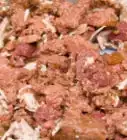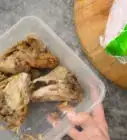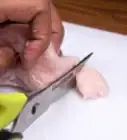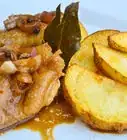This article was co-authored by wikiHow staff writer, Hannah Madden. Hannah Madden is a writer, editor, and artist currently living in Portland, Oregon. In 2018, she graduated from Portland State University with a B.S. in Environmental Studies. Hannah enjoys writing articles about conservation, sustainability, and eco-friendly products. When she isn’t writing, you can find Hannah working on hand embroidery projects and listening to music.
There are 8 references cited in this article, which can be found at the bottom of the page.
The wikiHow Video Team also followed the article's instructions and verified that they work.
This article has been viewed 132,414 times.
Learn more...
Chicken is a healthy and delicious dish that is easy to make at home. If you purchased a whole chicken, it may have come with giblets inside of it that have to be removed before you can start cooking. This may seem like a daunting task, but as long as you prepare your chicken correctly and make sure you find all of the giblets, you can remove them from your chicken quickly and safely.
Steps
Thawing and Unwrapping Your Chicken
-
1Thaw your chicken fully if it was frozen. Make sure that your chicken is not frozen. You can do this by soaking your chicken in cold water for a couple of hours, or letting it sit in your fridge for a few days if you have time. Your chicken doesn’t need to get up to room temperature, but it should not be frozen before you start preparing it.
- Cold water thawing takes about 30 minutes per 1 pound (0.45 kg) of chicken, while fridge thawing takes about 5 hours per 1 pound (0.45 kg) of chicken.[1]
-
2Take your fresh or thawed chicken out of its packaging. If your chicken is store-bought, it will most likely be wrapped in plastic or some other protective layer. Remove the packaging fully and make sure there are no bits of it stuck to your chicken. Immediately throw the packaging away in the garbage. Use scissors or a knife to cut the packaging off if you are having trouble.[2]
- From this point on, you’ll be touching raw meat with your bare hands, so be aware of any surfaces that you touch or tools that you handle so you can wash them later.
- Wash your hands often with soap and warm water to avoid the spread of salmonella.
Advertisement -
3Set your chicken on a sturdy and clean surface. This is usually a cutting board on a countertop, but you can also use a table or other hard surface. Make sure that whatever you set your chicken on can be cleaned well after you use it.[3]
- It’s a good idea to reserve a cutting board just for working with raw chicken, so you don’t cross-contaminate other foods.
Cleaning out the Chicken
-
1Find the neck and posterior ends of your chicken. It is important to know which side of the chicken is which. The neck end of your chicken will be closer to its wings, while the posterior end will be closer to its back legs.[4]
- The hole on the neck end of the chicken is usually smaller than the hole on the posterior end.
-
2Reach into the neck of your chicken to feel for the giblets. Your giblets may be wrapped up in a plastic bag, tied together in a mesh bag, or sitting in the chicken itself. Try the neck opening of your chicken first to see if you can feel whether or not the giblets are accessible from this point.[5]
-
3Reach into the posterior of your chicken to check for giblets there. If you couldn’t feel the giblets through the neck of the chicken, reach your hand into the posterior end of the chicken to feel for the giblets that way.[6]
- This opening on the chicken is bigger, so you might have an easier chance of finding them.
-
4Pull the giblets out of your chicken. You can pull them through either opening of the chicken. If your giblets are in a bag, they should be easy to grab all at once. If the giblets are loose in the chicken, you may have to pull the pieces out one by one. You can set the giblets aside to use in a recipe later, like gravy or giblets and liver, or you can throw them away. Most chicken giblets include:
- 1 neck
- 1 gizzard
- 1 heart
- 2 kidneys
- 1 liver[7]
-
5Check the posterior end for kidneys that might still be attached. If your giblets were loose inside of your chicken or if the giblet bag didn’t contain the kidneys, they might still be attached inside of your chicken. Look inside of the posterior of your chicken for dark red colored round objects near the opening.[8]
- If the kidneys are still attached, you can pull them out with your hands.
-
6Prepare and season your chicken like you normally would. Once you’ve removed the giblets, season and prepare the chicken according to the recipe you are following. You can roast chicken in the oven, put it in a slow cooker, or even fry it.
Warnings
- Do not eat raw or undercooked chicken, as it can make you very sick.⧼thumbs_response⧽
- Avoid the spread of salmonella by washing your hands and whatever surfaces come in contact with raw meat with soap and water.⧼thumbs_response⧽
- Don’t rinse your raw chicken. Doing so could spread dangerous bacteria around your kitchen or onto your clothes, increasing your chances of getting sick.[9]⧼thumbs_response⧽
Things You’ll Need
- 1 cutting board
- 1 pair of scissors or a knife (optional)
References
- ↑ https://www.cooksillustrated.com/how_tos/10331-thawing-frozen-meat-and-poultry?ref=HowTo_browse_12
- ↑ https://www.youtube.com/watch?v=LCEQmnjoKhY&feature=youtu.be&t=7
- ↑ https://www.cdc.gov/salmonella/general/prevention.html
- ↑ https://www.recipetips.com/kitchen-tips/t--1090/cleaning-chicken.asp
- ↑ https://paleoleap.com/complete-beginners-guide-giblets/
- ↑ https://paleoleap.com/complete-beginners-guide-giblets/
- ↑ https://www.thekitchn.com/what-are-giblets-65220
- ↑ https://www.fsis.usda.gov/wps/wcm/connect/8c532492-e9a6-43c7-abff-d5a00cb3f642/Giblets_and_Food_Safety.pdf?MOD=AJPERES
- ↑ https://www.nhs.uk/live-well/eat-well/never-wash-raw-chicken/
















































